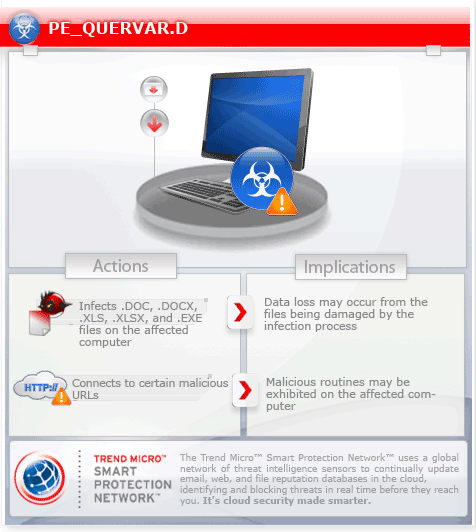PE_QUERVAR.D
Trojan.Exprez.B (Symatec), Mal/Behav-104 (Sophos)
Windows 2000, Windows XP, Windows Server 2003


Threat Type: File infector
Destructiveness: No
Encrypted:
In the wild: Yes
OVERVIEW
Downloaded from the Internet, Dropped by other malware
This file infector is reported to be spreading massively in the US and Europe. There are two factors about this malware that can explain this spreading: this malware infects common files that are usually shared (documents, spreadsheets, executables) and it targets mapped and removal drives.
To get a one-glance comprehensive view of the behavior of this File infector, refer to the Threat Diagram shown below.

This file infector arrives on a system as a file dropped by other malware or as a file downloaded unknowingly by users when visiting malicious sites. It may be manually installed by a user.
It creates folders where it drops its files. It injects its dropped file/component to specific processes.
It creates an infection marker in infected files.
TECHNICAL DETAILS
Varies
EXE
Yes
27 Aug 2012
Modifies files, Connects to URLs/IPs, Drops files
Arrival Details
This file infector arrives on a system as a file dropped by other malware or as a file downloaded unknowingly by users when visiting malicious sites.
It may be manually installed by a user.
Installation
This file infector drops the following component file(s):
- %User Profile%\Application Data\{Random Folder}\{Random File name}.EXE.LNK
- %User Profile%\Application Data\{Random Folder}\{Random File name}.EXE.INI
- {Malware Path and File name}.{extension of the original file} - normal file that has been previously infected by PE_QUERVAR.D-O.
(Note: %User Profile% is the current user's profile folder, which is usually C:\Documents and Settings\{user name} on Windows 2000, XP, and Server 2003, or C:\Users\{user name} on Windows Vista and 7.)
It drops and executes the following files:
- %User Profile%\Application Data\{Random folder}\{Random File name}.exe - detected as PE_QUERVAR.D-O
(Note: %User Profile% is the current user's profile folder, which is usually C:\Documents and Settings\{user name} on Windows 2000, XP, and Server 2003, or C:\Users\{user name} on Windows Vista and 7.)
It creates the following folders:
- %User Profile%\Application Data\{Random Folder}
(Note: %User Profile% is the current user's profile folder, which is usually C:\Documents and Settings\{user name} on Windows 2000, XP, and Server 2003, or C:\Users\{user name} on Windows Vista and 7.)
It injects its dropped file/component to the following processes:
- csrss.exe
It terminates itself if it finds the following processes in the affected system's memory:
- taskmgr.exe
Autostart Technique
This file infector modifies the following registry entry(ies) to enable its automatic execution at every system startup:
HKEY_CURRENT_USER\Software\Microsoft\
Windows NT\CurrentVersion\Windows
Load = "%User Profile%\Application Data\{Random Folder}\{Random Filename}.EXE.LNK"
File Infection
This file infector infects the following file types:
- EXE
- DOC
- DOCX
- XLS
- XLSX
It creates an infection marker in infected files.
Other Details
This file infector connects to the following possibly malicious URL:
- http://windows{BLOCKED}soft.com/update.apx
- http://{BLOCKED}w.com.br/includes/domit/way.php
- http://www.{BLOCKED}kes.com/way.php
- https://forum.{BLOCKED}vacy.com/image.php
SOLUTION
9.200
9.354.01
28 Aug 2012
9.355.00
28 Aug 2012
Step 1
Before doing any scans, Windows XP, Windows Vista, and Windows 7 users must disable System Restore to allow full scanning of their computers.
Step 2
Search and delete this file
- {Malware Path and File name}.{extension of the original file}
Step 3
Remove malware/grayware files dropped/downloaded by PE_QUERVAR.D. (Note: Please skip this step if the threats listed below have already been removed.)
Step 4
Scan your computer with your Trend Micro product and note files detected as PE_QUERVAR.D
Step 5
Restart in Safe Mode
Step 6
Search and delete this folder
- %User Profile%\Application Data\{Random Folder}
Step 7
Restore these modified registry values
Important:Editing the Windows Registry incorrectly can lead to irreversible system malfunction. Please do this only if you know how to or you can seek your system administrator's help. You may also check out this Microsoft article first before modifying your computer's registry.
- In HKEY_CURRENT_USER\Software\Microsoft\Windows NT\CurrentVersion\Windows
- From: Load = "%User Profile%\Application Data\{Random Folder}\{Random File name}.EXE.LNK"
To: Load = ""
- From: Load = "%User Profile%\Application Data\{Random Folder}\{Random File name}.EXE.LNK"
Step 8
Restart in normal mode and scan your computer with your Trend Micro product for files detected as PE_QUERVAR.D. If the detected files have already been cleaned, deleted, or quarantined by your Trend Micro product, no further step is required. You may opt to simply delete the quarantined files. Please check this Knowledge Base page for more information.
Did this description help? Tell us how we did.

